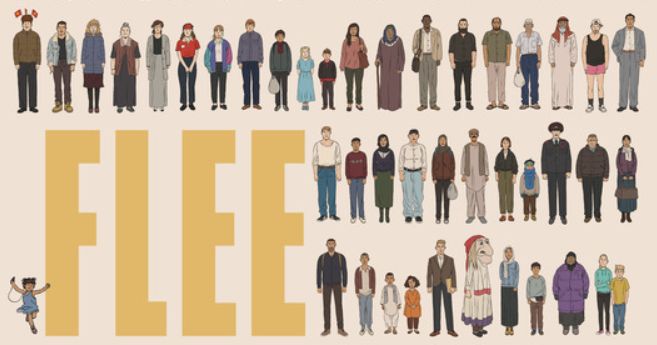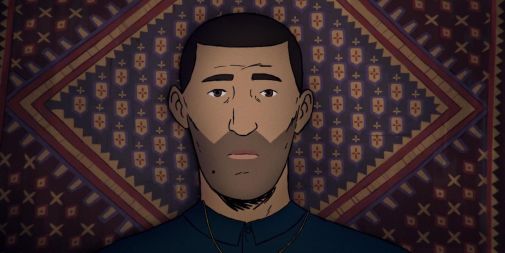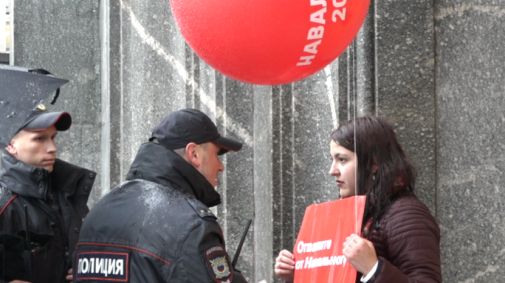Doc Corner: Denmark's Oscar Submission 'Flee' + 'We Are Russia' at DOC NYC
 Thursday, November 18, 2021 at 12:00PM
Thursday, November 18, 2021 at 12:00PM By Glenn Dunks

DOC NYC continues. The festival runs for in-person screenings from November 10–18 and then will carry over online until November 28. I have a Twitter thread covering what I am watching, but today we're looking at a big Oscar contender alongside a smaller, but no less worthy doc from the same part of the world.
I find it can often take a minute to get used to animated documentaries, the hand-crafted nature of the medium can be a barrier to the telling of these true-to-life stories. It's not unlike adjusting to 3D or VR, perhaps. But animation has become more and more common in documentary, particularly as a means of representing moments of history that couldn’t have been captured on film, though the quality can vary wildly. Like other acclaimed mostly animated documentaries such as Keith Maitland’s Tower and Ari Folman’s Waltz with Bashir, the much buzzed Flee quickly surpasses any up-front mental blocks. Here, the vivid, colourful animation brings out an even deeper well of emotion from émigré Amin Nawabi’s story in the same way blue eyes can bring out the colour of an item of clothing...
The key to the success of Jonas Poher Rasmussen’s film is that it embraces traditional documentary form as much as it pushes it. In telling the story of an Afghan family making passage across Europe following the Taliban incursion of the 1990s (so it’s timely, too), Flee does incorporate more traditional methods like talking heads and archival footage. But like Tower (one of the very best of the decade), which where possible weaved real footage of a Texas college campus shooting with striking block-colored animation, Flee finds powerful ways to merge the two. The film seeks to bold, underline and italicise the very human tragedy at its core, a tragedy that can too often be shrugged off if simply spoken about in sober academic terms.

If the use of animation—often as simple an adult Amin’s stubbled face etched against a patterned blanket staring upwards at us using rotoscoping technology—has the power to disarm and discombobulate and to get our imagination soaring, these glimpses of news reel from warzones and refugee anguish bring us back to earth. Like that use of real footage, elsewhere the narrative is frequently interrupted by a soundtrack of piercing pop tunes by A-Ha, Ace of Base, Daft Punk and Roxette that work to reel the viewer to a time and place of their own. It’s incredibly smart, really, if it wasn’t also a tactical choice to disguise the identity of its subjects.
Amin story obviously has many parts as it forges through a military invasion, a different kind of danger in Russia, and beyond. If not exactly twists, Flee routinely has an edge-of-your-seat quality to it that is visceral and cinematic. In contrast, Rasmussen is able to spot and enhance small moments to like a downward glance or a longing glace across an airport that sell the singular pain of Amin so beautifully. While real, they are given more of a central spotlight that means they cannot go unseen. That Flee is also a story of queer acceptance and not just an immigrant story is extremely important. Amin’s journey both physically and emotionally is what gives its final scenes such power as he discovers something like euphoria.
As an example of the expanding concept of both documentary and animation, it would make a fantastic ambassador for either at the Academy Awards. I hope they do right and nominate it—in a relatively quiet year for animation, is it too much to hope for a win?

While not as visually arresting or as far-reaching in its narrative as Flee, another documentary playing the festival that is worth checking out is We Are Russia. Alexandra Dalsbaek's film follows a small group of young activists on the streets of Moscow as they fight against the bold-faced corruption found within the government of Putin’s Russia and campaign for the progressive opposition, Alexei Navalny. Told through the eyes of these courageous volunteers (one of whom gets arrested multiple times over its short 75-minute runtime), Dalsbaek features some truly incredible footage that makes it one of the more important Russian documentaries of recent years. There's also one blindingly brilliant scene that feels like a real-life The Death of Stalin / The Office moment. It's certainly much more than the numerous ‘isn’t Putin wacky’ collages that tell us nothing of real substance.
To that matter, like Flee, it has something potent to say about how the personal stories of everyday people are often obfuscated by the larger, messier picture. In We Are Russia, we learn about the people who are angry and fighting for change, even if it is seemingly a fruitless endeavour. It’s hardly surprising to learn that David France was on hand to present the film at DOC NYC. This and France’s sadly under-recognised Welcome to Chechnya make a fascinating, infuriating pair.



Reader Comments (1)
Really looking forward to seeing FLEE.